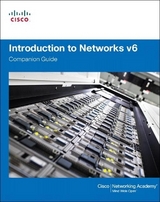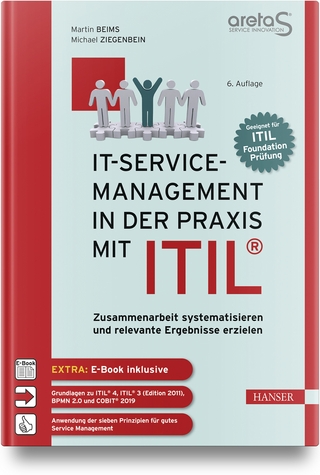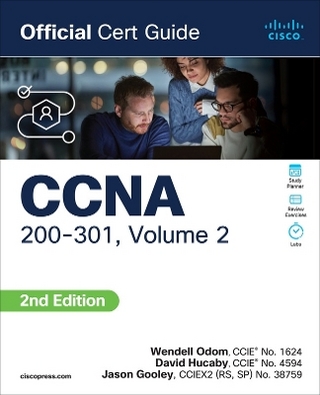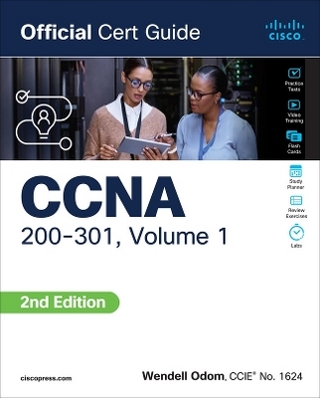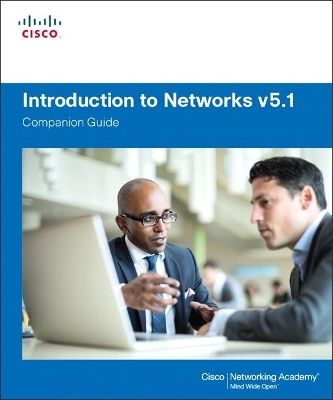
Introduction to Networks Companion Guide v5.1
Cisco Press (Verlag)
978-1-58713-357-2 (ISBN)
- Titel erscheint in neuer Auflage
- Artikel merken
Introduction to Networks Companion Guide v5.1 is the official supplemental textbook for the Introduction to Networks course in the Cisco® Networking Academy® CCNA® Routing and Switching curriculum. The course introduces the architecture, structure, functions, components, and models of the Internet and computer networks. The principles of IP addressing and fundamentals of Ethernet concepts, media, and operations are introduced to provide a foundation for the curriculum. By the end of the course, you will be able to build simple LANs, perform basic configurations for routers and switches, and implement IP addressing schemes.
The Companion Guide is designed as a portable desk reference to use anytime, anywhere to reinforce the material from the course and organize your time.
The book’s features help you focus on important concepts to succeed in this course:
Chapter Objectives—Review core concepts by answering the focus questions listed at the beginning of each chapter.
Key Terms—Refer to the lists of networking vocabulary introduced and highlighted in context in each chapter.
Glossary—Consult the comprehensive Glossary with more than 250 terms.
Summary of Activities and Labs—Maximize your study time with this complete list of all associated practice exercises at the end of each chapter.
Check Your Understanding—Evaluate your readiness with the end-ofchapter questions that match the style of questions you see in the online course quizzes. The answer key explains each answer.
Introduction xxiv
Chapter 1 Explore the Network 1
Objectives 1
Key Terms 1
Introduction (1.0.1.1) 3
Globally Connected (1.1) 4
Networking Today (1.1.1) 4
Providing Resources in a Network (1.1.2) 7
LANs, WANs, and the Internet (1.2) 11
Network Components (1.2.1) 11
LANs and WANs (1.2.2) 20
The Internet, Intranets, and Extranets (1.2.3) 23
Internet Connections (1.2.4) 25
The Network as a Platform (1.3) 28
Converged Networks (1.3.1) 28
Reliable Network (1.3.2) 30
The Changing Network Environment (1.4) 35
Network Trends (1.4.1) 35
Networking Technologies for the Home (1.4.2) 39
Network Security (1.4.3) 42
Network Architecture (1.4.4) 44
Summary (1.5) 47
Warriors of the Net (1.5.1.2) 47
Conclusion (1.5.1.3) 47
Practice 48
Class Activities 48
Labs 49
Packet Tracer Activities 49
Check Your Understanding Questions 49
Chapter 2 Configure a Network Operating System 53
Objectives 53
Key Terms 53
Introduction (2.0.1.1) 54
IOS Bootcamp (2.1) 54
Cisco IOS (2.1.1) 55
Cisco IOS Access (2.1.2) 58
Navigate the IOS (2.1.3) 61
The Command Structure (2.1.4) 64
Basic Device Configuration (2.2) 68
Hostnames (2.2.1) 68
Limit Access to Device Configurations (2.2.2) 70
Save Configurations (2.2.3) 72
Address Schemes (2.3) 78
Ports and Addresses (2.3.1) 78
Configure IP Addressing (2.3.2) 81
Verifying Connectivity (2.3.3) 85
Summary (2.4) 87
Practice 88
Class Activities 88
Labs 88
Packet Tracer Activities 88
Check Your Understanding Questions 89
Chapter 3 Network Protocols and Communications 91
Objectives 91
Key Terms 91
Introduction (3.0) 92
Rules of Communication (3.1) 92
The Rules (3.1.1) 93
Network Protocols and Standards (3.2) 100
Protocols (3.2.1) 100
Protocol Suites (3.2.2) 105
Standard Organizations (3.2.3) 114
Reference Models (3.2.4) 118
Data Transfer in the Network (3.3) 123
Data Encapsulation (3.3.1) 123
Data Access (3.3.2) 127
Summary (3.4) 135
Practice 136
Class Activities 136
Labs 136
Packet Tracer Activities 136
Check Your Understanding Questions 137
Chapter 4 Network Access 141
Objectives 141
Key Terms 141
Introduction (4.0) 143
Physical Layer Protocols (4.1) 143
Physical Layer Connection (4.1.1) 143
Purpose of the Physical Layer (4.1.2) 146
Physical Layer Characteristics (4.1.3) 150
Network Media (4.2) 155
Copper Cabling (4.2.1) 155
UTP Cabling (4.2.2) 163
Fiber-Optic Cabling (4.2.3) 168
Wireless Media (4.2.4) 176
Data Link Layer Protocols (4.3) 179
Purpose of the Data Link Layer (4.3.1) 179
Media Access Control (4.4) 185
Topologies (4.4.1) 185
WAN Topologies (4.4.2) 187
LAN Topologies (4.4.3) 190
Data Link Frame (4.4.4) 196
Summary (4.5) 203
Practice 204
Class Activities 204
Labs 204
Packet Tracer Activities 205
Check Your Understanding Questions 205
Chapter 5 Ethernet 209
Objectives 209
Key Terms 209
Introduction (5.0) 210
Ethernet Protocol (5.1) 211
Ethernet Frame (5.1.1) 211
Ethernet MAC Addresses (5.1.2) 216
LAN Switches (5.2) 226
The MAC Address Table (5.2.1) 226
Switch Port Settings (5.2.3) 244
Address Resolution Protocol (5.3) 247
MAC and IP (5.3.1) 247
ARP (5.3.2) 250
ARP Spoofing (5.3.3.2) 265
Summary (5.4) 266
Practice 267
Class Activities 267
Labs 267
Packet Tracer Activities 267
Check Your Understanding Questions 268
Chapter 6 Network Layer 273
Objectives 273
Key Terms 273
Introduction (6.0) 274
Network Layer Protocols (6.1) 275
Network Layer in Communications (6.1.1) 275
Characteristics of the IP Protocol (6.1.2) 277
IPv4 Packet (6.1.3) 281
IPv6 Packet (6.1.4) 283
Routing (6.2) 287
How a Host Routes (6.2.1) 287
Router Routing Tables (6.2.2) 291
Routers (6.3) 296
Anatomy of a Router (6.3.1) 296
Router Boot-up (6.3.2) 303
Configure a Cisco Router (6.4) 308
Configure Initial Settings (6.4.1) 308
Configure Interfaces (6.4.2) 312
Configure the Default Gateway (6.4.3) 314
Summary (6.5) 319
Practice 320
Class Activities 321
Labs 321
Packet Tracer Activities 321
Check Your Understanding Questions 321
Chapter 7 IP Addressing 325
Objectives 325
Key Terms 325
Introduction (7.0) 327
IPv4 Network Addresses (7.1) 327
Binary and Decimal Conversion (7.1.1) 327
IPv4 Address Structure (7.1.2) 338
IPv4 Unicast, Broadcast, and Multicast (7.1.3) 345
Types of IPv4 Addresses (7.1.4) 350
IPv6 Network Addresses (7.2) 357
IPv4 Issues (7.2.1) 357
IPv6 Addressing (7.2.2) 360
Types of IPv6 Addresses (7.2.3) 364
IPv6 Multicast Addresses (7.2.5) 385
Connectivity Verification (7.3) 388
ICMP (7.3.1) 388
Testing and Verification (7.3.2) 392
Summary (7.4) 398
Practice 399
Class Activities 399
Labs 400
Packet Tracer Activities 400
Check Your Understanding Questions 400
Chapter 8 Subnetting IP Networks 403
Objectives 403
Key Terms 403
Introduction (8.0) 404
Subnetting an IPv4 Network (8.1) 405
Network Segmentation (8.1.1) 405
Subnetting an IPv4 Network (8.1.2) 408
Subnetting a /16 and /8 Prefix (8.1.3) 421
Subnetting to Meet Requirements (8.1.4) 427
Benefits of Variable Length Subnet Masking (8.1.5) 432
Addressing Schemes (8.2) 440
Structured Design (8.2.1) 440
Design Considerations for IPv6 (8.3) 443
Subnetting an IPv6 Network (8.3.1) 443
Summary (8.4) 449
Practice 450
Class Activities 450
Labs 451
Packet Tracer Activities 451
Check Your Understanding Questions 451
Chapter 9 Transport Layer 455
Objectives 455
Key Terms 455
Introduction (9.0) 456
Transport Layer Protocols (9.1) 457
Transportation of Data (9.1.1) 457
TCP and UDP Overview (9.1.2) 464
TCP and UDP (9.2) 474
TCP Communication Process (9.2.1) 474
UDP Communication (9.2.3) 488
TCP or UDP (9.2.4) 491
Summary (9.3) 494
Practice 495
Class Activities 496
Labs 496
Packet Tracer Activities 496
Check Your Understanding Questions 496
Chapter 10 Application Layer 501
Objectives 501
Key Terms 501
Introduction (10.0) 502
Application Layer Protocols (10.1) 502
Application, Presentation, and Session (10.1.1) 502
How Application Protocols Interact with End-User Applications (10.1.2) 506
Well-Known Application Layer Protocols and Services (10.2) 510
Web and Email Protocols (10.2.1) 510
IP Addressing Services (10.2.2) 516
File Sharing Services (10.2.3) 525
Summary (10.3) 529
Practice 530
Class Activities 530
Labs 530
Packet Tracer Activities 531
Check Your Understanding Questions 531
Chapter 11 Build a Small Network 533
Objectives 533
Key Terms 533
Introduction (11.0) 534
Network Design (11.1) 534
Devices in a Small Network (11.1.1) 534
Small Network Applications and Protocols (11.1.2) 539
Scale to Larger Networks (11.1.3) 544
Network Security (11.2) 547
Security Threats and Vulnerabilities (11.2.1) 547
Network Attacks (11.2.2) 550
Network Attack Mitigation (11.2.3) 556
Backup and Restore Configuration Files (11.2.5) 564
Network Testing and Verification (11.3) 572
The ping Command (11.3.1) 572
The traceroute and tracert Command (11.3.2) 577
Show Commands (11.3.3) 581
Host and IOS Commands (11.3.4) 585
Debugging (11.3.5) 592
Network Troubleshooting (11.4) 594
Troubleshooting Methodologies (11.4.1) 594
Troubleshoot Cables and Interfaces (11.4.2) 598
Troubleshooting Scenarios (11.4.3) 600
Summary (11.5) 606
Practice 608
Class Activities 608
Labs 608
Packet Tracer Activities 608
Check Your Understanding Questions 609
Appendix A 613
Glossary 627
TOC, 9781587133572, 5/19/2016
| Erscheinungsdatum | 06.08.2016 |
|---|---|
| Reihe/Serie | Companion Guide |
| Verlagsort | Indianapolis |
| Sprache | englisch |
| Maße | 211 x 234 mm |
| Gewicht | 1408 g |
| Themenwelt | Mathematik / Informatik ► Informatik ► Netzwerke |
| Informatik ► Weitere Themen ► Zertifizierung | |
| ISBN-10 | 1-58713-357-1 / 1587133571 |
| ISBN-13 | 978-1-58713-357-2 / 9781587133572 |
| Zustand | Neuware |
| Haben Sie eine Frage zum Produkt? |
aus dem Bereich
